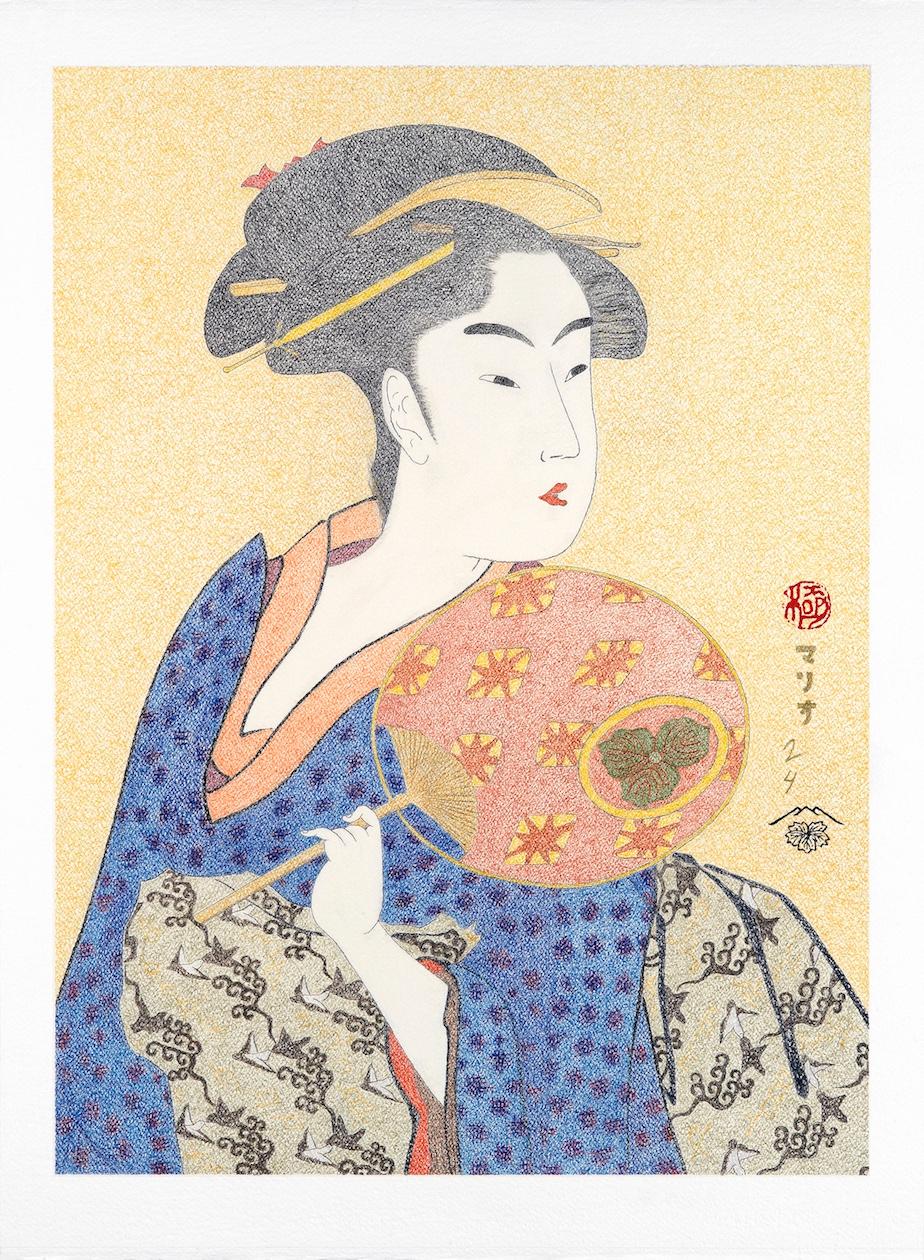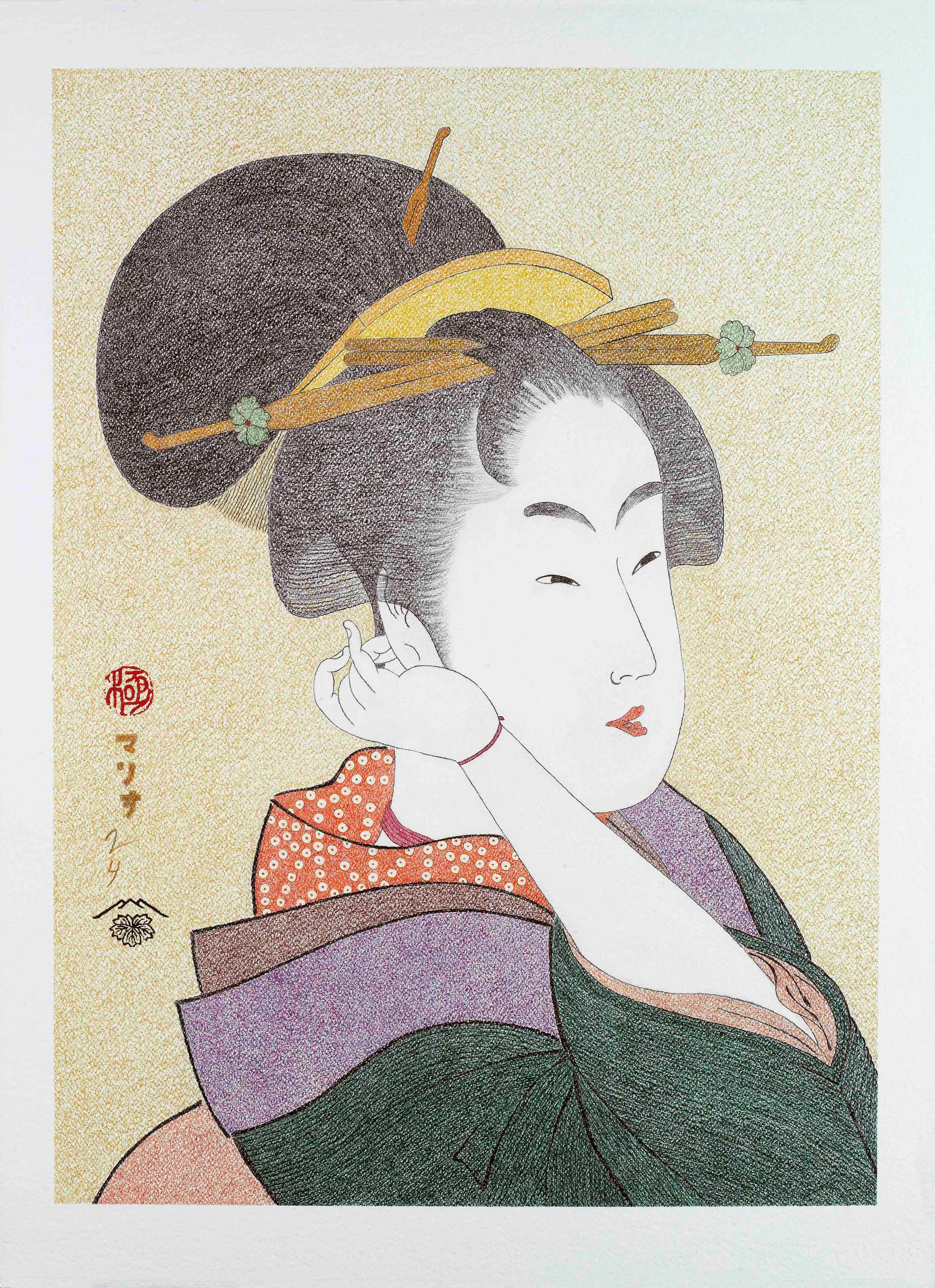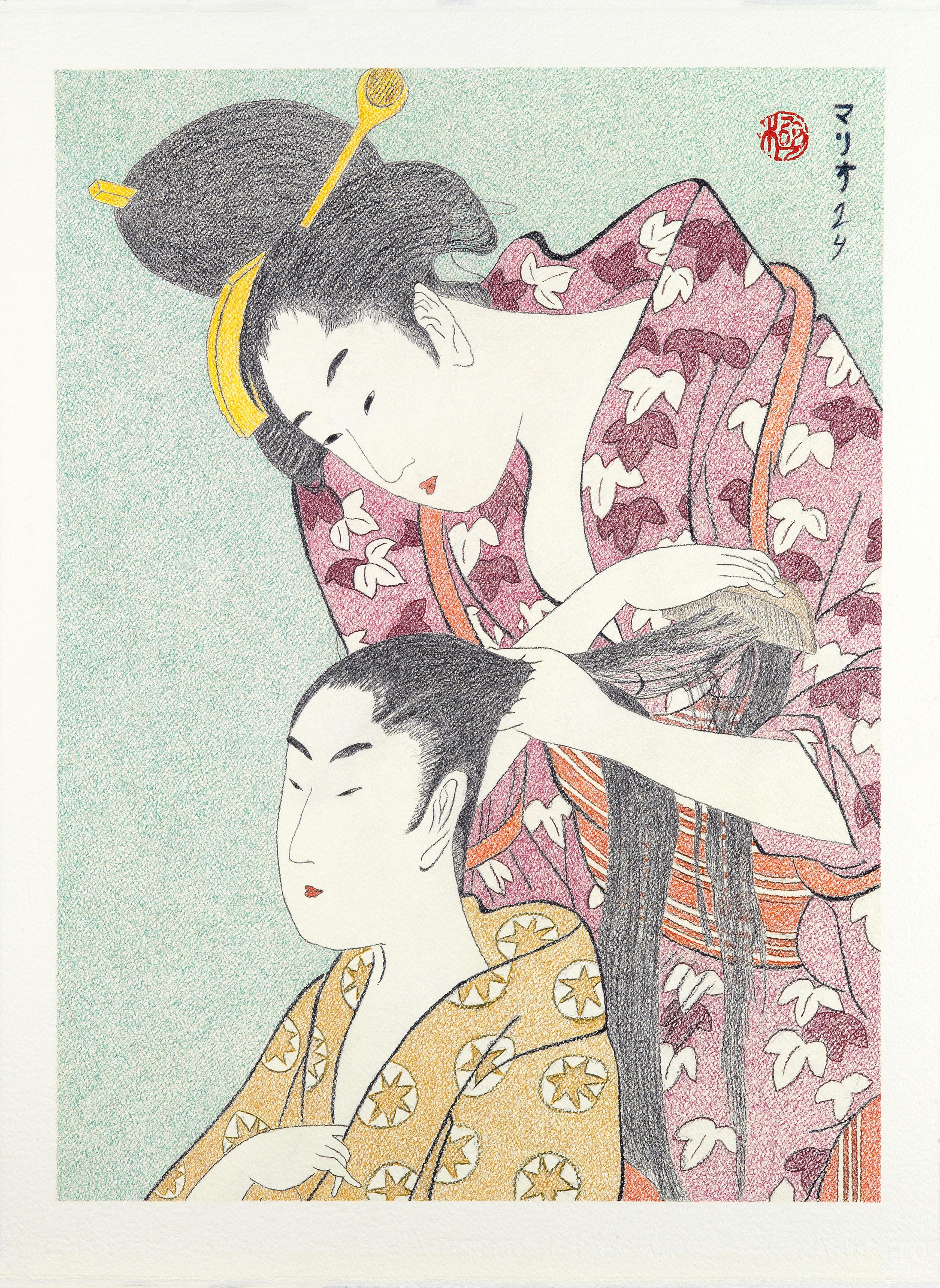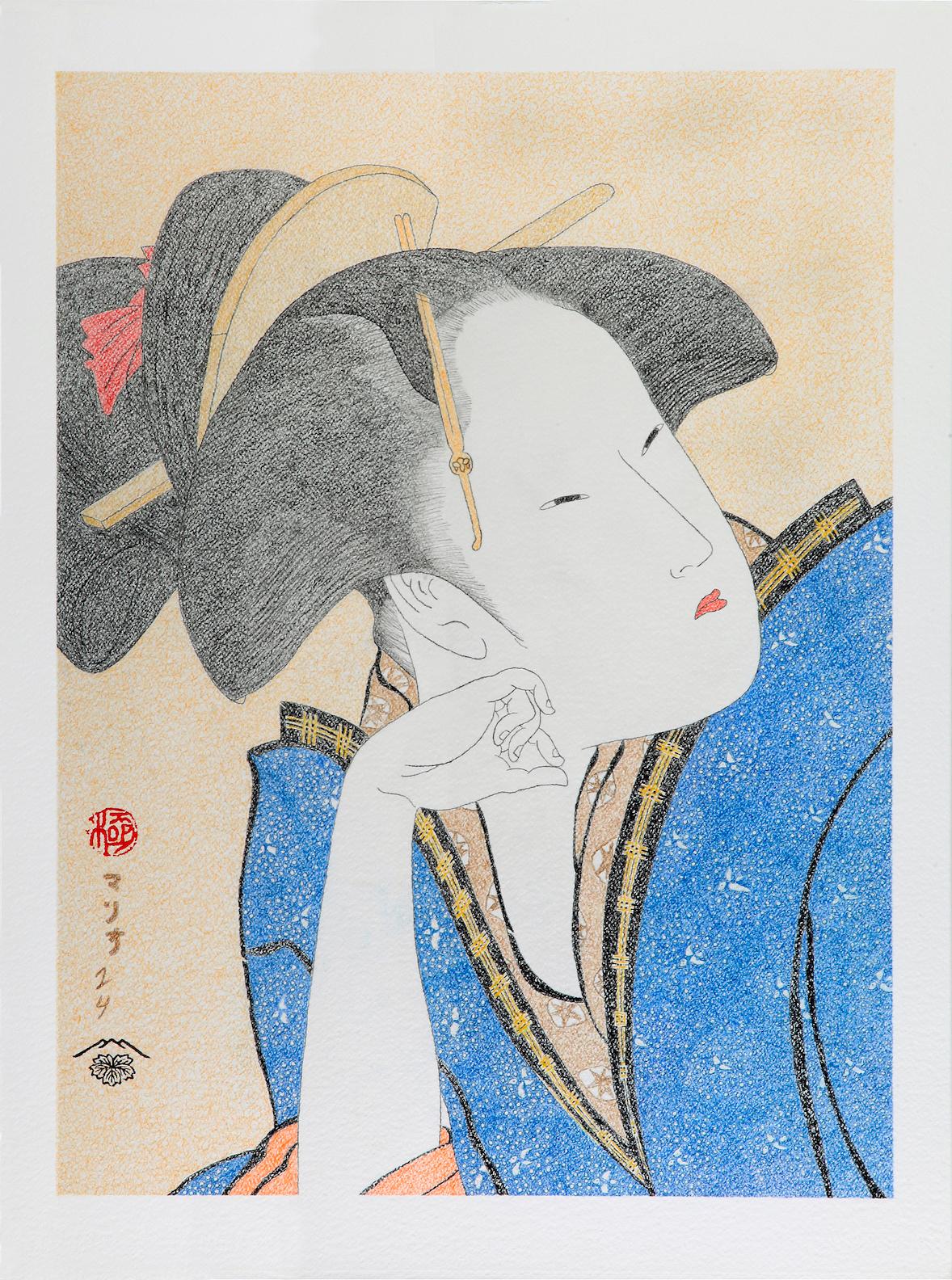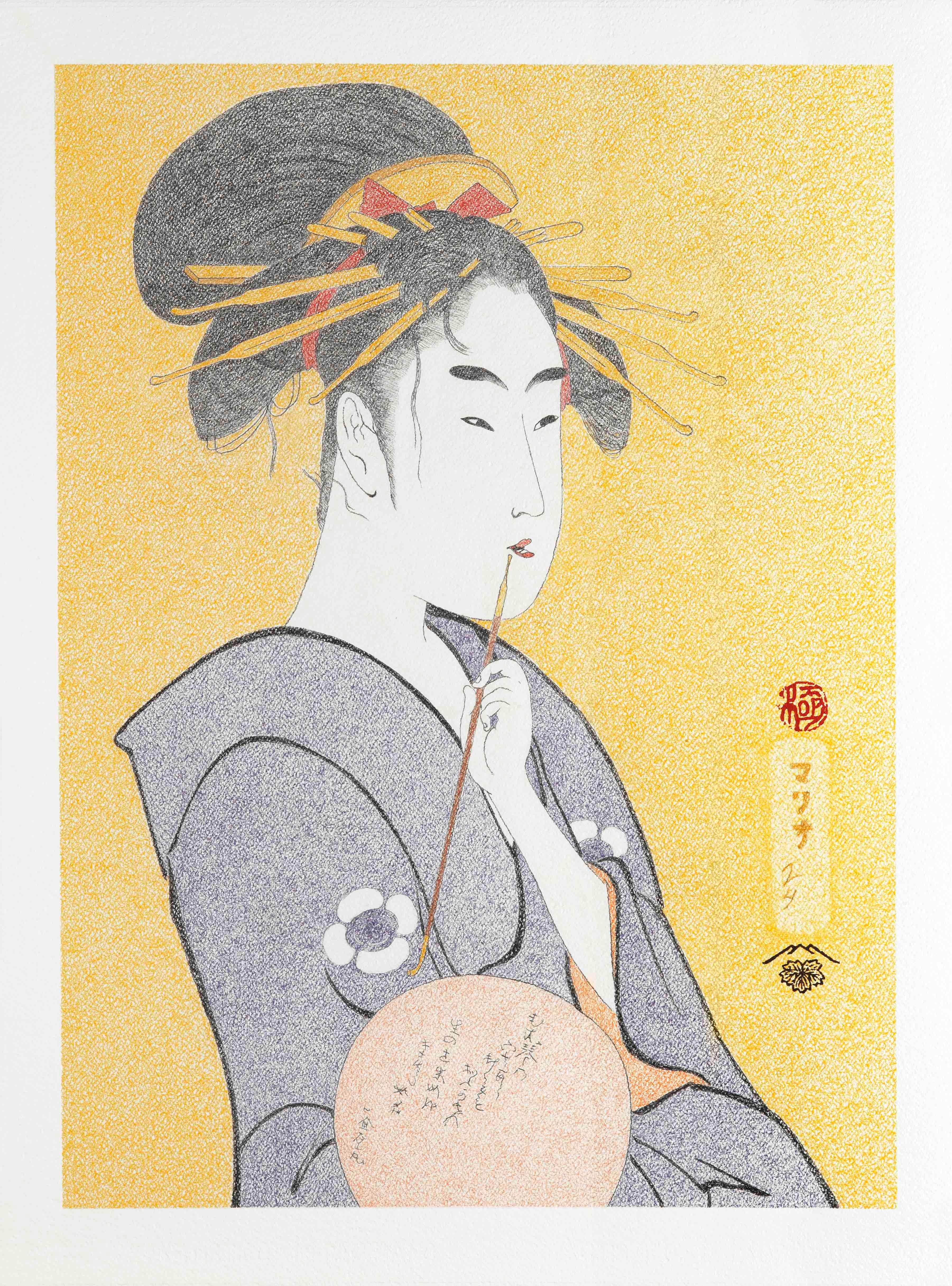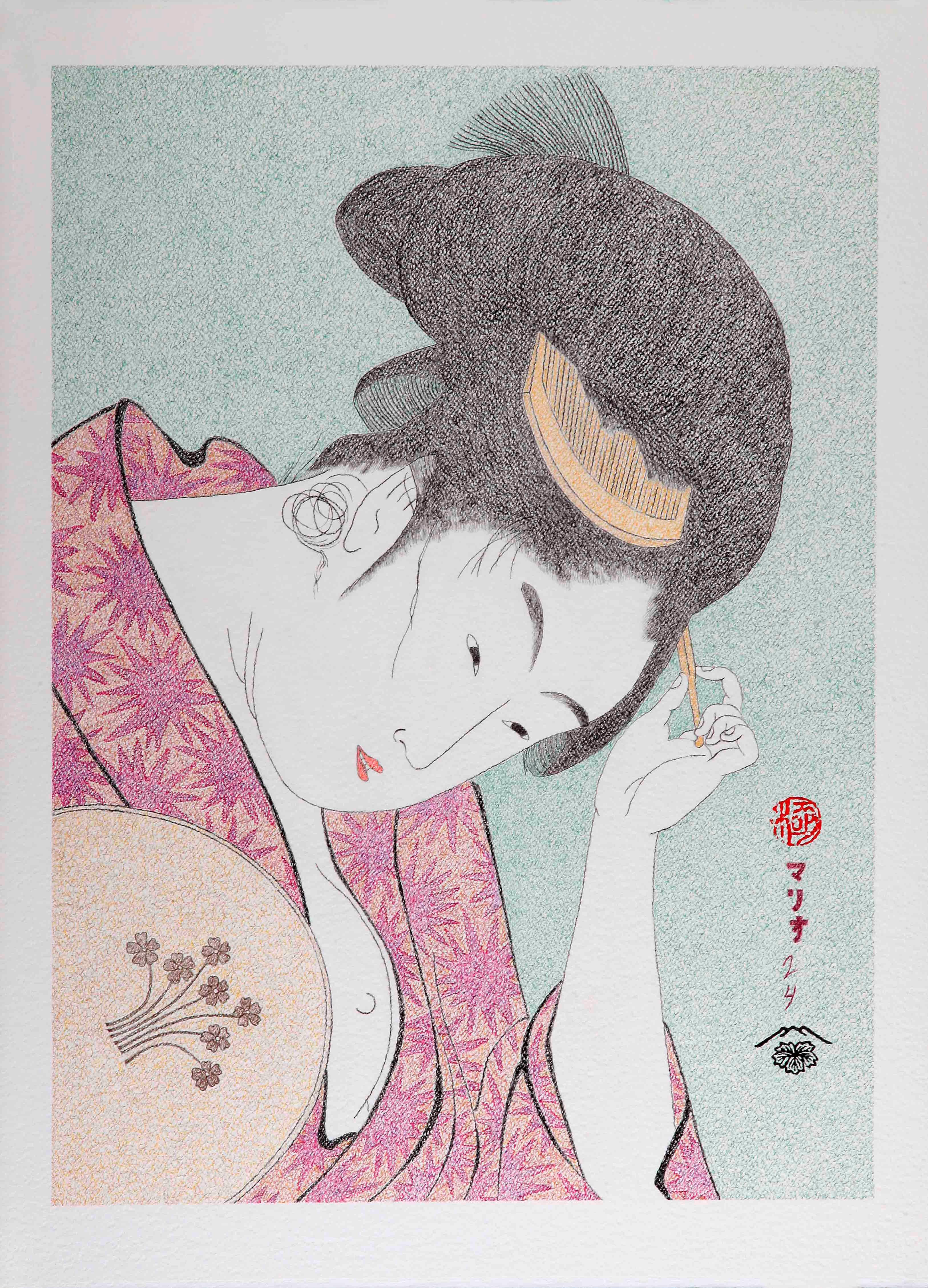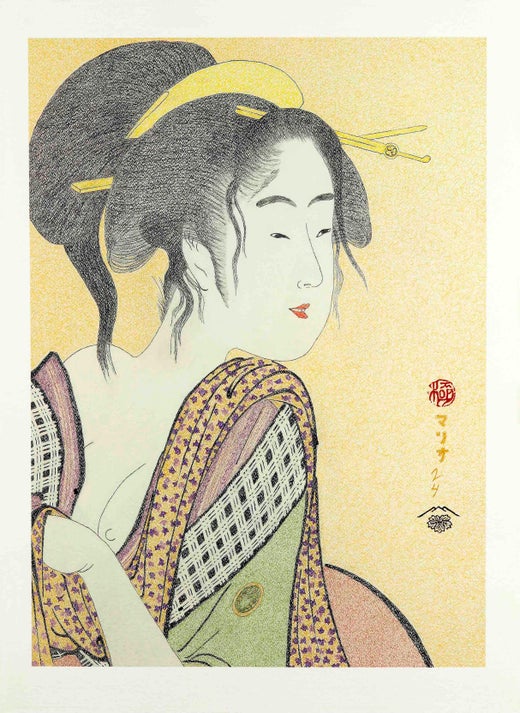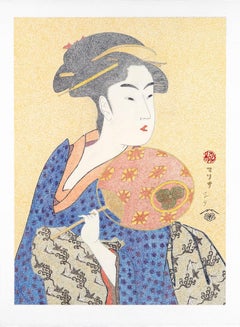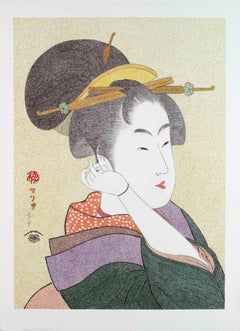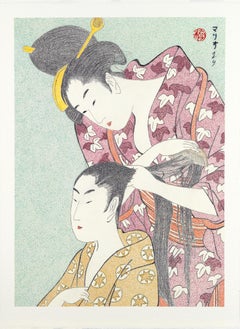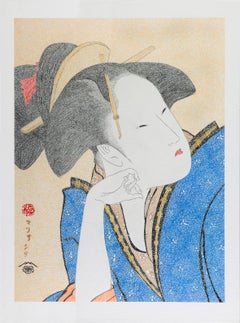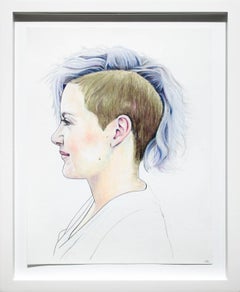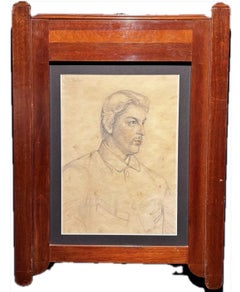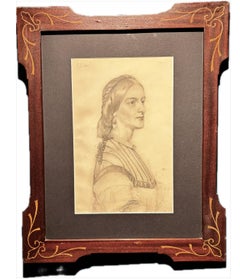Items Similar to Japanese Art Ukiyo-e Figurative Painting, Hitomoto of the Daimonjiya, Edo period
Want more images or videos?
Request additional images or videos from the seller
1 of 13
Mario B. GilJapanese Art Ukiyo-e Figurative Painting, Hitomoto of the Daimonjiya, Edo period2014
2014
About the Item
“Hitomoto of The Daimonjiya in Kyô-Machi Itchôme”
Hitomoto holds a bouquet of flowers looking to her left, with a surprised face, and with her mouth ajar. She seems to be in conversation with another person, while performing the ikebana, or flower arrangement.
The flowers suspended on the top, indicate us that they are in preparation for a celebration.
The drawing of her clear eyes, on her profiled face is particularly highlighted. The bulk of her hairstyle and her long neck stands out on the kimono with geometric figures.
She holds the flowers with a delicate gesture of her little finger.
The lightening of the background in the central part of the sheet contrasts with the darker colors of the hairstyle and kimono, giving vitality to the image
This image is part of the bijin-ga series (“Pretty women”) drawn by Mario BGil, based in the Kitigawa Utamaro woodblock print “Hitomoto of The Daimonjiya in Kyô-Machi Itchôme” (Kamuro Senkaku and Banki, from an untitled series of courtesans compared to flowers), (1802), 35,5 x 24,1 cm. Museum of Fine Arts (Boston-USA).
The artist reproduces the seal of the censor (Kiwame) and from the original publisher (Tsutaya, climbing leaf)), between the two, the signature of Mario BGil written in Japanese, with the date 14 (2014).
The mesaurements of the drawing are 76 x 56 cm. (29,92 x 22,05 in.), with a painted surface of 67 x 49,5 cm. and framed 88 x 67 cm. The frame has a museum glass, which does not reflect. This piece cannot be exported outside of Europe to prevent risks with framing.
With his work on the bijing-ga series, Mario BGil wanted to embellish, give brilliance and volume to the images presented by japanese artist Kitigawa Utamaro in those beautiful engravings, ennobled with the patina of time, which have served as inspiration. The result obtained is almost life-size portraits, endowed with strong chromaticism and valuable contrasts, all enhanced, in turn, with the volume provided by the weight and rigidity of the paper, and its thick texture (Fabriano Artistico “grana grosso”, 640g/m2; the thickness and hardness of the paper makes it necessary to transport it without rolling).
In this way, Mario BGil pays tribute to his admired artist and offers us a new and enriched vision of this popular facet of oriental art from the 18th and 19th centuries.
ABOUT THE ARTIST
Mario BGil is a self-taught artist who for years has combined his creative activity with his work in the business world, away from commercial art galleries. Man of very diverse interests and great artistic sensitivity, studied Art History and in 2012, a deep interest in oriental art was awakened in him so that he began to study the great masters of Japanese Ukiyo-e prints, who had such an influence on the European avant-garde of the late 19th century.
The discovery of Kitagawa Utamaro (1753-1806), a key figure in the metropolitan culture of Edo (now Tokyo), and a point of reference in the history of Japanese engraving, meant for Mario a change of course caused by the imperative need to study his images, recreate them and recreate himself in them, incorporating certain changes in both the format and the technique used.
The technique used by MBG is very different from that used in engravings with wooden blocks impregnated in inks of intense colors that serve as a model. On a paper of heavy weight and thick texture, Mario BGil outlines with a black pencil, and colors the spaces with pencils and watercolors. Faced with the intensity of color of the prints (already very lost in some of them due to their age and exposure to the sun), their drawings are sifted by the streaky white, due to the thick texture of the paper, showing more lines, soft and warmer tones, giving color to the backgrounds but leaving all the volumes corresponding to the skin blank, thus giving the figures a classic serenity that transcends their oriental character.
Between 2014 and 2015, Mario BGil made more than 35 drawings based on the prints selected from the huge amount of work produced by the master Utamaro that shows images of courtesans in different attitudes and poses that highlight the subtle delicacy of oriental feminine beauty.
Kitagawa Utamaro was a faithful representative of the tastes of the Japanese bourgeoisie of its time, which had transformed the life of the cities giving birth to a culture parallel to the official and aristocratic.
The activity of the new rising group took place in special neighborhoods of Edo (Tokyo) and Osaka and its banality, inconsistency and frivolity earned it the name of Ukiyo: "floating world"; a world that will give priority to a series of cultural manifestations much more popular and less intellectualized than those preferred by the nobility. The new neighborhoods are filled with brothels and shows that the upper classes will consider vain, and a new breed of heroes: sumo wrestlers, singers, actors and courtesans will come to reign in this "floating world."
In front of the traditional painting the stamp arises with images of this new world. The courtesans of the pleasure districts of Edo that Utamaro portrays, do not always appear perfectly dressed to receive the client, but are surprised while getting ready, or during the day. He observes them without being seen, spy on them in their daily and intimate work. All of them are women drawn in a similar style, with elongated faces, straight delicate noses (almost a single line) and other features reduced to a mere suggestion (the mouth, a tiny butterfly of red).
The importance that it has had in later European artists (Degas, Toulouse-Lautrec, Bonnard, Gauguin, Van Gogh ...) has been great and Mario BGil has not been able to escape the recreation of those images so classic and, at the same time, so current, paying clear tribute to its original creator.
- Creator:Mario B. Gil (1962)
- Creation Year:2014
- Dimensions:Height: 34.65 in (88 cm)Width: 26.38 in (67 cm)Depth: 1.38 in (3.5 cm)
- Medium:
- Movement & Style:
- Period:
- Condition:The real condition is New, but the artist framed it to have it in his own home. As this piece is framed, it cannot be exported outside of Europe to prevent risks with framing.
- Gallery Location:Segovia, ES
- Reference Number:1stDibs: LU74437971292
BIOGRAPHY Mario BGil is a self-taught artist who for years has combined his creative activity with his work in the business world, away from commercial art galleries. Man of very diverse interests and great artistic sensitivity, studied Art History and in 2012, a deep interest in oriental art was awakened in him so that he began to study the great masters of Japanese Ukiyo-e prints, who had such an influence on the European avant-garde of the late 19th century. The discovery of Kitagawa Utamaro (1753-1806), a key figure in the metropolitan culture of Edo (now Tokyo), and a point of reference in the history of Japanese engraving, meant for Mario a change of course caused by the imperative need to study his images, recreate them and recreate himself in them, incorporating certain changes in both the format and the technique used. The technique used by MBG is very different from that used in engravings with wooden blocks impregnated in inks of intense colors that serve as a model. On a paper of heavy weight and thick texture, Mario BGil outlines with a black pencil, and colors the spaces with pencils and watercolors. Faced with the intensity of color of the prints (already very lost in some of them due to their age and exposure to the sun), their drawings are sifted by the streaky white, due to the thick texture of the paper, showing more lines, soft and warmer tones, giving color to the backgrounds but leaving all the volumes corresponding to the skin blank, thus giving the figures a classic serenity that transcends their oriental character. Between 2014 and 2015, Mario BGil made more than 35 drawings based on the prints selected from the huge amount of work produced by the master Utamaro that shows images of courtesans in different attitudes and poses that highlight the subtle delicacy of oriental feminine beauty. Kitagawa Utamaro was a faithful representative of the tastes of the Japanese bourgeoisie of its time, which had transformed the life of the cities giving birth to a culture parallel to the official and aristocratic. In front of the traditional painting, the stamp arises with images of this new world. The courtesans of the pleasure districts of Edo that Utamaro portrays, do not always appear perfectly dressed to receive the client but are surprised while getting ready, or during the day. He observes them without being seen, and spies on them in their daily and intimate work. All of them are women drawn in a similar style, with elongated faces, straight delicate noses (almost a single line), and other features reduced to a mere suggestion (the mouth, a tiny butterfly of red). The importance that it has had in later European artists (Degas, Toulouse-Lautrec, Bonnard, Gauguin, Van Gogh ...) has been great and Mario BGil has not been able to escape the recreation of those images so classic and, at the same time, so current, paying clear tribute to its original creator.
About the Seller
5.0
Vetted Professional Seller
Every seller passes strict standards for authenticity and reliability
Established in 2002
1stDibs seller since 2017
66 sales on 1stDibs
Typical response time: <1 hour
- ShippingRetrieving quote...Shipping from: Bilbao, Spain
- Return Policy
Authenticity Guarantee
In the unlikely event there’s an issue with an item’s authenticity, contact us within 1 year for a full refund. DetailsMoney-Back Guarantee
If your item is not as described, is damaged in transit, or does not arrive, contact us within 7 days for a full refund. Details24-Hour Cancellation
You have a 24-hour grace period in which to reconsider your purchase, with no questions asked.Vetted Professional Sellers
Our world-class sellers must adhere to strict standards for service and quality, maintaining the integrity of our listings.Price-Match Guarantee
If you find that a seller listed the same item for a lower price elsewhere, we’ll match it.Trusted Global Delivery
Our best-in-class carrier network provides specialized shipping options worldwide, including custom delivery.More From This Seller
View AllJapanese Art Ukiyo-e Figurative Painting, Takashimayaoisha, Edo period
Located in Segovia, ES
Beijing-ga Series XXX (nº 30)
Title: “Takashimaohisa”
Ohisa, along with Okita and Tomimoto Toyohina, were the three most famous beauties of the time. The first two were waitresses...
Category
2010s Edo Figurative Drawings and Watercolors
Materials
Crayon, Paper, Oil Crayon, Graphite
Japanese Art Ukiyo-e Figurative Painting, Tatsumi Roko, Edo Period
Located in Segovia, ES
Bijin-ga series XXVIII (Nº 28)
Title: Tatsumi Roko
Portrait of Tatsumi Roko, a geisha of the pleasure quarters in the Edo period. The image belongs to the series Renowed Beauties Likened to the Six Inmortal Poets.
The popular top-class geishas of the day , known as “oiran”, were depicted in this type of print. In ukiyo-e woodblock prints, this close-up portrait view of the upper body is known as an okubi-e (bust portrait).
This image is part of the bijin-ga series (“Pretty women”) drawn by Mario BGil, based in the Kitigawa Utamaro woodblock print...
Category
2010s Edo Figurative Drawings and Watercolors
Materials
Paper, Crayon, Oil Crayon, Graphite
Japanese Art Ukiyo-e Figurative Painting, Hairdresser, Edo period
Located in Segovia, ES
Bijin-ga series II (nº 02)
Title: “Hairdresser”
The interest in this picture is focused on the hairstyles of both women, a hairdresser leaning forward with a bow of intense black color, arranging his client's especially long hair. The ways of gripping both the hair and the comb, making it slide through the ocher-scented kimono of the customer, decorated with sea stars, stand out. Highlighting with great detail the drawing of loose hair on the obi of white lines on a red background, and the kosode of plum color.
This image is part of the Bijin-ga Series (“Pretty women”) drawn by Mario BGil, based in the Kitigawa Utamaro woodblock print "Hairdresser" (1798-1799), 39,8 x 26,8 cm. Museum of Fine Arts. Boston-USA.
Utamaro drawn a series of twelve prints whose themes were related to the manual works of women, and this "Hairdresser" is one of them.
Mario BGil reproduces the seal of the censor (Kiwame) and writes his own signature, Mario BGil, in Japanese, with the date 14 (2014).
The mesaurements of the drawing are 76 x 56 cm. (29,92 x 22,05 in.), with a painted surface of 67 x 49,5 cm.
With his work on the bijing-ga series, Mario BGil wanted to embellish, give brilliance and volume to the images presented by japanese artist Kitigawa Utamaro in those beautiful engravings, ennobled with the patina of time, which have served as inspiration. The result obtained is almost life-size portraits, endowed with strong chromaticism and valuable contrasts, all enhanced, in turn, with the volume provided by the weight and rigidity of the paper, and its thick texture (Fabriano Artistico “grana grosso”, 640g/m2; the thickness and hardness of the paper makes it necessary to transport it without rolling).
In this way, Mario BGil pays tribute to his admired artist and offers us a new and enriched vision of this popular facet of oriental art from the 18th and 19th centuries.
ABOUT THE ARTIST
Mario BGil is a self-taught artist who for years has combined his creative activity with his work in the business world, away from commercial art galleries. Man of very diverse interests and great artistic sensitivity, studied Art History and in 2012, a deep interest in oriental art was awakened in him so that he began to study the great masters of Japanese Ukiyo-e prints, who had such an influence on the European avant-garde of the late 19th century.
The discovery of Kitagawa Utamaro (1753-1806), a key figure in the metropolitan culture of Edo (now Tokyo), and a point of reference in the history of Japanese engraving...
Category
2010s Edo Figurative Drawings and Watercolors
Materials
Paper, Crayon, Oil Crayon, Graphite
Japanese Art Ukiyo-e Figurative painting, Reflective Love, Edo period
Located in Segovia, ES
Bijing-Ga Series XII (Nº 12)
Title: Reflective Love.
Lovely portrait of a beauty looking over her shoulder.
In Reflective Love (from the Utamaro...
Category
2010s Edo Figurative Drawings and Watercolors
Materials
Paper, Crayon, Oil Crayon, Graphite
$4,604 Sale Price
28% Off
Japanese Art Ukiyo-e Figurative Painting, The courtese Hinakoto, Edo period
Located in Segovia, ES
Bijin-ga series XXI (Nº 21)
Title: The courtese Hinakoto of the Hyôgorô House of Edo
The courtesan Hinakoto is depicted by smoking tobacco. She takes the pipe delicately in her left hand and, in her right hand, she seems to be holding a “uchiwa” (rigid hand fan) that comes out from the bottom of the drawing, decorated with written calligraphy. Some strands of hair that fall on her temple and her scant clothing show that the painter has surprised her in a relaxed moment in which she does not lose her elegance and slenderness.
This image is part of the bijin-ga series (“Pretty women”) drawn by Mario BGil, based in the Kitigawa Utamaro woodblock print...
Category
2010s Edo Figurative Drawings and Watercolors
Materials
Paper, Crayon, Oil Crayon, Graphite
Japanese Art Ukiyo-e Figurative Painting, The fickle type, Edo period
Located in Segovia, ES
Bijing-ga Series XXII (Nº 22)
Title: THE FLICKLE TYPE
Upper half of the body of a woman in yukata (summer kymono) with part of her chest bare. Depicted just after a bath, she is turning her head and drying her hands with the towel hang on her shoulder. Her just-washed hair is tied around an ornate hairpin, the hair style called bai-mage (spiral-shell chignon).
The unkempt hair of the nape and the movement of the hands one on the other are clear examples of Utamaro's mastery, who had an exceptionally observant eye for women.
The Fickle ( or Fancy-free) Type is flirting with more than one member of the opposite sex
This image is part of the bijin-ga series (“Pretty women”) drawn by Mario BGil, based in the Kitigawa Utamaro woodblock print...
Category
2010s Edo Figurative Drawings and Watercolors
Materials
Paper, Crayon, Oil Crayon, Graphite
You May Also Like
"Truer Than True" ballpoint pen, figurative portrait
By Lauren Rinaldi
Located in Philadelphia, PA
Original drawing by Lauren Rinaldi float mounted in the pictured simple white frame measuring 17in x 14in.
Lauren Rinaldi works using unbiased portraits of women’s bodies as a veh...
Category
21st Century and Contemporary Contemporary Portrait Drawings and Waterco...
Materials
Archival Paper, Ballpoint Pen, Graphite, Oil Pastel
"Veneer" Figurative Drawing, Color Pencil, Ballpoint Pen, Graphite
By Lauren Rinaldi
Located in Philadelphia, PA
"Veneer" is an original oil pastel, ballpoint pen, color pencil, and graphite on arches paper work by Lauren Rinaldi. This piece ships in the pictured archival custom frame. The pape...
Category
21st Century and Contemporary Contemporary Figurative Drawings and Water...
Materials
Oil Pastel, Archival Paper, Ballpoint Pen, Color Pencil, Graphite
" Studio per ritratto di Philip Bedingfeld" 1870 ca cm. 25 x 36
Located in Torino, IT
Studio a matita e pastelli per lo splendido ritratto di Philip Bedingfeld proprietà del Museo del Norfolk
Frederick Sandys, (Norwich, 1º maggio1829 ...
Category
1870s Pre-Raphaelite Portrait Drawings and Watercolors
Materials
Crayon, Graphite, Paper
$7,496 Sale Price
35% Off
Free Shipping
" Studio per Ritratto di Lady Anne Simms Reeve of Brancaster Hall " 1870 ca
Located in Torino, IT
Raro studio dell'artista Preraffaellita Frederick Sandys,Studio per l’opera
Portrait of a Lady,( Anne Simms Reeve of Brancaster Hall, Norfolk) proprie...
Category
1870s Pre-Raphaelite Portrait Drawings and Watercolors
Materials
Crayon, Graphite
$8,996 Sale Price
35% Off
Free Shipping
Young Leo. From The art, culture & society Series series
By Manuel Santelices
Located in Miami Beach, FL
Movies, TV and magazines are constant source of inspiration. Fame, as fleckring and shallow it can be sometimes, is very intriguing to him.
The worlds of fashion, society and pop cu...
Category
21st Century and Contemporary Contemporary Figurative Drawings and Water...
Materials
Paper, Watercolor, Pencil, Graphite
Portrait of a Gentleman in a Redingote by student od Jean Louis David drawing
Located in Norwich, GB
An exceptional ink, wash and graphite portrait of a gentleman by Henri-Joseph Hesse, dating from circa 1820, the time of the Bourbon restoration in France. It depicts a dashing figur...
Category
Early 19th Century French School Portrait Drawings and Watercolors
Materials
Paper, Ink, Graphite
Recently Viewed
View AllMore Ways To Browse
Edo Period Art
Edo Period Japanese Art
Japanese Course
B Boston Artist
Japan Engraving
Ukiyo E
Japanese Ukiyo E
Edo Period Japanese Painting
Glass Do E
Edo Japanese Woodblock
Business And Pleasure
18th Century Paintings Of Women
Edo Period Woodblock
Series Of Black And White Face Drawings
Japanese Kimono Painted
Japanese Woodblock Beauties
Japanese 19th Century Flower Painting
Black Painted Ink Stands
